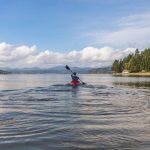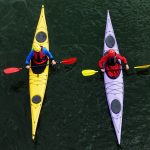In other words, some kayaks are equipped with a rudder and some are not. It is doable to put a rudder on a kayak that was not designed to have one, however, it usually takes more effort.
Kayaks that are ready to use a rudder will have more than one screw hole in the back where the rudder’s holder can connect. The equipment will also feature channels that simplify stringing the cables and hoisting the lines.
If the kayak is lacking two particular traits, holes will have to be created in the stern for mounting purposes by drilling. It is generally wise to run ropes and hoists on the surface of the kayak.
This is an issue because if a rudder is installed on a kayak not intended for this purpose, the vessel’s buoyancy may be affected. If you pursue this path, you will require a scheme to patch the openings drilled so your kayak can remain as buoyant as when it was made.
Perhaps a better inquiry here would be: which kayaks necessitate a rudder?
For long excursions or camping in a kayak, a rudder will be beneficial. Furthermore, sea kayaks used for fishing often have rudders mounted on them to make navigation easier with the current and tides.
Installing a rudder on your kayak can be beneficial if you frequent a spot that is susceptible to sudden strong winds. However, if you just take a recreational kayak out for short amounts of time when the weather is good, you will probably be fine without a rudder most of the time.
How to Mount Your Kayak Rudder
Setting up a kayak rudder can be straightforward if the kayak is made for rudder accessories, however constructing a rudder framework can be hard if the kayak does not have the capability for it.
For rudder-ready kayaks, the installation process can be as simple as:
Put the mounting bracket into the holes that have already been drilled.
Step 2: Insert the rudder into the mounting bracket.
Attach the lift lines to the rudder mount, then place them into the pre-cut openings.
Fourth Step: Install the foot pedals in the seat area of the kayak.
Attach the cables for the rudder to the pedals and the rudder support.
Just like that, you’re ready to get paddling!
building a DIY Rudder
If your exact kayak model does not have a rudder kit available, or if you are feeling adventurous, you can certainly try creating your own rudder. You have a variety of options in regards to what to use for the rudder blade.
rudder Parts
This model makes use of commonplace plywood which is covered with a marine-grade lacquer to ensure it is waterproof. This construction requires some rope for the cords, metal L-brackets, a metallic swivel-mount, carabiners for linking, and a bit of ¾-inch PVC piping for the foot pedals.
mounting the Blade
Beginning at the back, he placed a bolt through a hole already present from the kayak maker in order to lock the anchor line. He put a yoke end on the head of the bolt to connect it to the upper part of the blade, and then used another bracket to secure the lower side.
This creates the main axis around which the blade can rotate, and the extent of this rotation is decided by the length of the cables it is linked to. You have the ability to manipulate the degree to which this rudder influences your steering, by adjusting the length of the blade in accordance with your own wishes.
securing the Steering Lines
He fastened the blade to the aligned pivot point and linked it up to the upper corners of the blade using bolts, nuts, and washers.
You must bore two openings on the top boundary of the blade in order to achieve this. Ensure that they are positioned far enough so that the top limits of the brackets are equivalent to the top boundary of the blade when they are fitted.
The most straightforward approach to complete this task is to place the brackets where they’re needed and then mark through the bracket openings. Then remove the bracket and drill your holes.
After the brackets were put in place, the kayaker arranged two small loops of rope through the hole in the bracket further away from the paddle. He avoided securing the carabiners directly onto the slots as they often jammed and stopped the blade from functioning properly.
You can connect one carabiner to each of these tiny rope circles and then direct your rope steering lines toward the cockpit. Think about installing a tiny U-shaped bracket about halfway between the L-brackets and the foot pedals to pass the steering lines through.
This will ensure that they don’t topple over the edge of the kayak or become entangled among the items you’re stuffing in the rear storage space. Ensure the size of the U-brackets is sufficiently big in order for the rope to have the capacity to move back and forth without being obstructed.
making Foot Pedals
For this design, he used a piece of PVC pipe arranged crosswise to the length of the kayak. The position of the rudder is comparable to the kayak’s cockpit and can be easily manipulated by the kayaker’s feet while in the seat of the kayak.
He put a ScottyMount in the middle of the kayak and created a square shape from PVC and then connected the longer section of PVC to it and fastened it.
Make a couple of holes in the PVC that lines this extended part, so that the other two clips can be affixed to them. Be sure not to feed the carabiners too far into the PVC tubing so that they can be easily inserted.
Once you have attached the rope steering lines to the carabiners, you are then ready to attempt to use your home-made kayak rudder.
in conclusion
Adding a rudder to your kayak can greatly enhance your paddling experience and help you navigate through challenging water conditions with ease.
By following the step-by-step instructions outlined in this guide, you can install a rudder on your kayak in no time. Remember to choose the right type of rudder for your kayak and to properly adjust and test it before heading out on the water.
With a little practice, you’ll be able to steer your kayak like a pro and enjoy your time on the water even more. So go ahead and give it a try!




